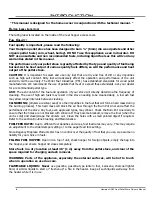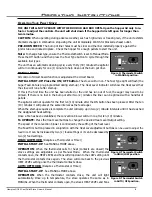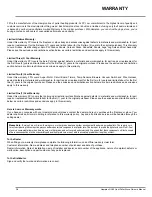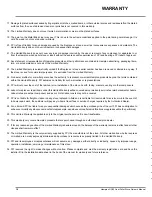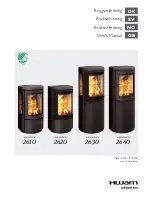
will drop down to the LOW setting for 30 minutes. If the thermostat contacts close within the 30 minutes, the
HEAT LEVEL will return to the previous MANUAL setting. If the thermostat contacts remain open, the stove
automatically begins its shutdown routine. The stove will re-light when the thermostat contacts close again.
t
uRning
y
ouR
p
eLLet
S
tove
o
FF
:
•
MANUAL and HI / LOW mode: To turn the unit OFF, simply press the ON / OFF button. This will stop the feed of
pellets. The blowers will continue to operate and cool the stove down. When cool enough, the stove will turn off.
•
AUTO / OFF mode: To turn the unit OFF, turn the Thermostat down or Timer off.
•
On shut down the burn pot agitator will run continuously for five (5) minutes on premium mode, one (1) minute
on regular mode, and five (5) minutes on low grade / multi-fuel Pellet mode.
DO NOT turn unit off during start-up or unplug unit while operating; this may lead to
smoke escaping from the stove.
S
LideR
/d
ampeR
S
et
-u
p
:
This is used to regulate the airflow through the pellet stove.
Convection
Fan
Slider
Damper
Slider Damper
Set Screw with
5
/
16
" Hex Head
Removable Plate
& Exhaust Sensor
location
Combustion
Blower
Note: The side panel,
& back grill are
removed for clarity.
Operating Instructions
figure 6: slider/damper plate in unit.
This unit is designed to operate within a negative pressure range of
0.15-0.17 inches of water column (37-42
Pa).
This can be measured using a Magnahelic pressure gauge once the unit has been running on heat level 5
setting after one hour of burn time. This adjustment is necessary for varying venting configurations. The reading
can be taken from the ⅛” hole located on the right side of the Ash Box.
The Combustion Trim, Feed Trim and Fuel Type Functions can be used to compensate for varying fuel qualities.
Refer to the Owners Manual for circuit board operation.
If, after long periods of burning, the fire builds up or there is a build up of clinkers, this would be a sign that the
fuel quality is poor - this requires more air.
The easiest way to make sure that an efficient flame is achieved is to understand the characteristics of the fire.
• A tall, lazy flame with dark orange tips requires more air.
• A short, brisk flame, like a blowtorch, has too much air .
• If the flame is in the middle of these two characteristics with a bright yellow/orange, active flame with no black
tips then the air is set for proper operation, refer to Figure 7.
SPECIAL NOTES:
Fuel quality is a major factor in how the stove will operate. If the fuel has a high moisture content or ash content the
fire will be less efficient and has a higher possibility of the fire building up and creating clinkers (hard ash build-up).
Hampton GC60 Cast Pellet Stove Owner’s Manual
10




